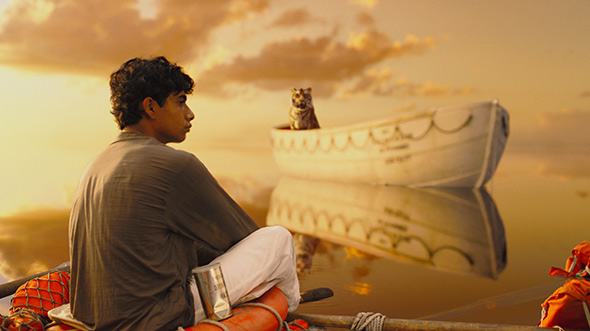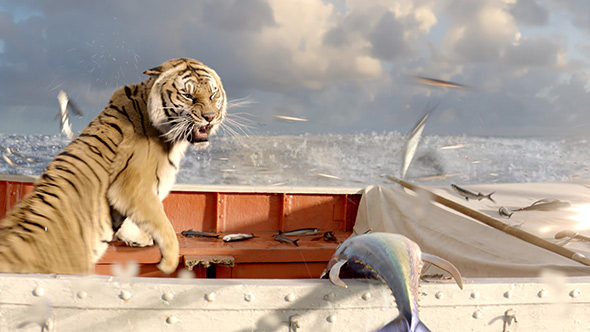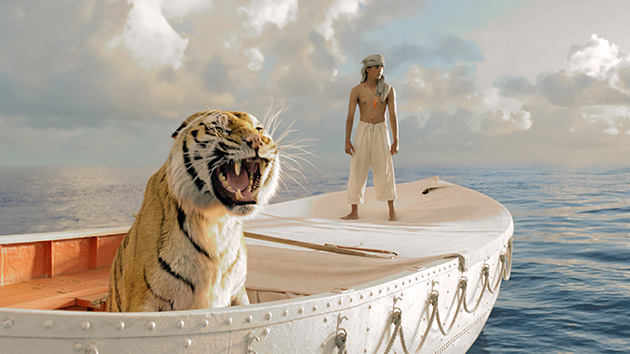Eight Weeks on Set with a Boy and a Blue Screen ... and Tigers Too
Bill Westenhofer’s Oscar nomination for the visual effects in Life of Pi is his third Academy Award nomination and fourth BAFTA nomination. In 2008, he received a visual effects Oscar and a BAFTA award for his work on The Golden Compass. The visual effects supervisor has spent his career at Rhythm & Hues, where he first worked as a technical director on Batman Forever in 1994. His first award was a BAFTA nomination for supervising the visual effects on Babe: Pig in the City in 1999, and he received his first Oscar nomination and second BAFTA nomination in 2006 for The Chronicles of Narnia: The Lion, the Witch and the Wardrobe. Like many visual effects professionals, this award-winning supervisor brings a background in art and technology to his work. He put aside painting and drawing to study computer engineering as an undergraduate, and in graduate school, he studied physically-based animation, receiving a master’s degree in computer science from George Washington University.
In addition to Westenhofer, visual effects supervisor Guillaume Rocheron at the Moving Picture Company, animation director Erik De Boer at Rhythm & Hues, and special effects technician Donald Elliott received Oscar nominations for Life of Pi. Rhythm & Hues artists created all the digital animals and the digital ocean except for the storm sequences by artists at the Moving Picture Company. Teams at Lola, Look Effects, Crazy Horse, and yU+Co also contributed to the film. Ang Lee directed the 20th Century Fox release, which received 11 Oscar nominations including Best Picture, Best Director, and Best Cinematography.

StudioDaily: Why do you think your peers voted to nominate Life of Pi for a visual effects Oscar?
Westenhofer: It has an artistic quality. One of the really cool things that’s happened with visual effects is that we’ve shown we can do just about anything. Ang [Lee] told us he wanted to make art with this film. The visual effects department had to create the art he wanted to portray.
How much of this film relied on work by the visual effects crews?
We have a boy and a blue screen. Just about everything else from the point the ship sinks until we’re on the beach is visual effects; the whole ocean journey. Ang wanted the ocean and the sky to be characters. There were no real skies. The live action plates [during the ocean journey] were mostly blue-screen, shot in a custom water tank built in Taiwan that could produce an ocean swell. We had the option of using that water, but when we did, we had to extend it to make the ocean look big.

OK, the sky was always digital during the ocean journey and the water was usually digital. What about the lifeboat and the raft?
We replaced the real boat in situations where we had to take over the ocean, and in a lot of shots with the tiger when we wanted more freedom with the camera. During the flying fish sequence, it made sense to replace the boat since the flying fish would pile up. Whenever the tiger hops on the tarp, it’s digital. There were times when even though we shot a scene in the tank and got genuine movement, the only thing we pulled out of the plates was Pi. The raft was real more often than not, but in the distance and in MPC’s storm sequence, we replaced it.
Did you have a real tiger on set?
We had four tigers on set. When I’m 80 years old, I will still remember spending eight weeks with a real tiger.
Why did you have so many?
In Pi, it’s a story point that the animals are not anthropomorphized. So, I told Ang we needed genuine reference. And, Ang wanted to hold our feet to the fire anyway. He wanted our tiger as real as we could make him. Having the tigers there gave us a real target. For Narnia, we had begged and borrowed to get a day with a lion. For Pi, we wanted to pull reference clips for as many shots as we could to keep ourselves honest. We modeled Richard Parker, our digital tiger, after one tiger named King. The others could do different actions better. We filmed the tigers for three of the eight weeks. The rest of the time was for rehearsal. And during the entire time, we took photoreference – on the boat, yawning, their foot pads – we had hundreds of hours of reference.
Was Richard Parker, the tiger in the film, mostly real or mostly digital?
Of the 170 tiger shots, only 20 were real.
What did you learn from having the tigers there that you didn’t already know?
The tigers are phenomenal. Everything about a tiger’s face is designed to mesmerize their prey. They look at you and you feel frozen.
Here’s a great example of why it was important to have reference: There’s a scene when the tiger pops out from under the tarp, sees the ocean, and freaks out but in a tiger way. We wanted to know how a real tiger would respond. You know how a person looks when he gets nervous? You might think a tiger would act that way, too. But having the tigers and the trainer there, we learned that when a tiger gets scared, it looks as nonchalant as possible. It kneads its paws. It looks away. The tiger wants you to think you’re not fazing him.

You said that 20 percent of the tiger shots used the real tiger. How did you shoot the real tigers?
We had a gimbaled boat and a fake camera in the tiger compound so we could rehearse and film in the same place. In the movie, when the tiger jumps out of the boat the first time and swims, that’s a real tiger. The tiger wanted to swim out of the tank and get to a safe spot. The other big sequence with a real tiger was when Pi tries to tame Richard Parker with the stick. We choreographed the scene under the trainer’s direction. When you see a stick coming into the frame, a trainer is at the other end.
What about the other animals?
The orangutan was as challenging as the tiger. The hyena. The whale. The flying fish. The meerkats. We had people working on animals for eight or nine months. The meerkats were a blast. We put things in the back that most people won’t see. There’s a meerkat up in the tree above Pi looking straight at the lens.
Which was more difficult? The digital tiger? The water? Or something else?
Ang wanted to film in stereo 3D, which made everything 10 times more complicated. And, not only that, there are 690 visual effects shots, but there are only 960 cuts in the entire film. There are more 2000-frame shots than I’ve worked on in my entire career.
We had a lot of confidence with the tiger shots and we had done ocean work before. But we were sitting right on the surface of the water, and we had to blend the tank water with the CG water in stereo. Ang wanted the water to be a character, but he wanted us to make it as real as possible.
When we were on set, even though I acted confident, I knew we would have a lot of work to do to blend the water.
So, you were like the tiger – acting confident despite knowing everything would be hard later?
Ha. Exactly. That’s great. Yes, I acted as nonchalant as possible. I’d say, ‘Yeah, of course we can blend it.”
What did you do to help make the blending of digital and real water successful?
We took a lot of video as they built the tank and ran tests with wave markers. I had a grid on the side of the tank and we calibrated our [digital] wave tools to match. All our math was exactly right.
Do you think stereo 3D helped or hindered your effort to create an artistic film?
When I told people that Ang wanted this to be a [stereo] 3D film, they would ask, “Why?” There was a lingering thought that [3D] had to be in an action film to make sense. One of the genius things Ang did was to take us out in a Coast Guard cutter in a storm. I took pictures with a 2D camera and they were so underwhelming. The information in the waves was lost. So, despite occasional cursing that 3D makes things harder, we can see the ocean in 3D. We can see the swells, the drama of being on the ocean.
You said none of the skies are real. How did you create them?
Ang had a specific vision, but he wasn’t super specific. He’d say that he wanted the sky to be melancholy. We gave someone a nice job: To sit on a beach in Florida and snap high resolution HDRI images when he saw a pretty sky. We had a library of 200 shots from sunsets to cloudy skies. We’d use the photography directly or the matte painting department would combine images and adjust colors. We’d pick examples to show Ang to find out if that’s what he had in mind.
I’ve heard you say that working on this film gave you one of the most rewarding feelings you’ve had in a long time. Why?
I was an artist way before I started working with computers. Drawing and painting. This is the first time it felt like a direct application of that in the employ of doing visual effects.
Do you have a favorite shot in the film?
One of my favorite shots is with Pi in the lifeboat with the hyena and the other animals. He stands up and calls for help, and he realizes he’s completely lost. When I was on the cutter, on the way back the seas started to calm down. The waves were a little smoother with incredibly fine detail. The sunlight came through the clouds causing a silvery shimmer on the water. That’s what we chose for this shot. Beauty, but with a desolated, isolated look. The combination of our sky and the pattern of the [digital] waves created this effect.
Do you think the visual effects in this film will influence future filmmakers?
I hope it spurs an appreciation of visual effects by anyone who might not have that appreciation already — that visual effects can play a part in selling a vision. I think people know that. But I think this film shows it isn’t so much about what you do, but how you use the tools.
Did you enjoy this article? Sign up to receive the StudioDaily Fix eletter containing the latest stories, including news, videos, interviews, reviews and more.











Brilliant work!